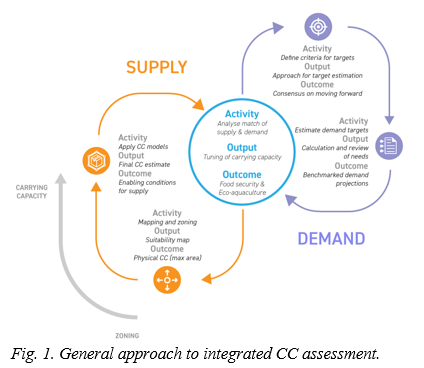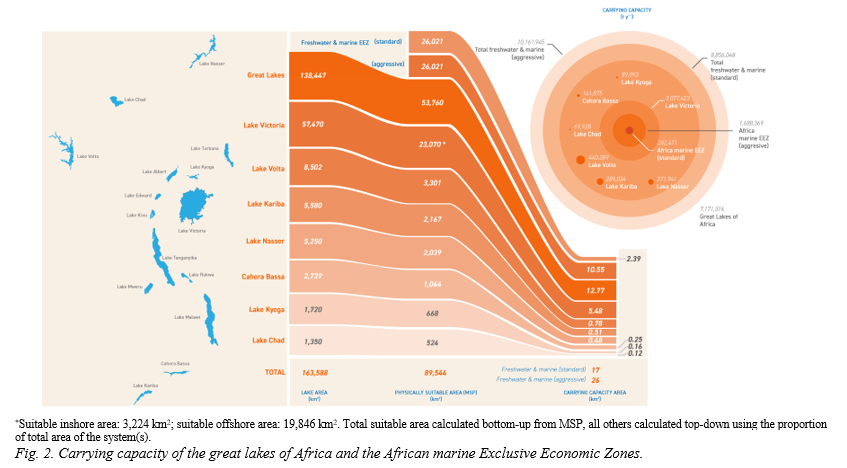AQRATE – AN INTEGRATED MODEL FOR QUANTIFYING AQUACULTURE CARRYING CAPACITY IN MARINE AND FRESHWATER SYSTEMS
Introduction
Aquatic food security is increasingly dependent on farming and accounts for over 57% of all finfish and shellfish consumed worldwide (FAO, 2024). The overwhelming majority of aquaculture takes place in emerging economies (88 % of the 131 X 106 t annual production
in 2022 (FAO, 2024 )), which are largely responsible for the consistent 6-8% annual increase in production. This growth rate, fuelled by the twin pressures of human population expansion and the need to increase per capita consumption of fish, and stimulated by the stagnation or decrease in wild capture for key species, is a clear environmental and social pressure (Costello et al, 2020).
To ensure the sustainable growth of aquaculture, given limited resources such as space and water quality and the need to balance competing uses and equilibrium of ecological, economic, and social factors, it is essential to determine carrying capacity (CC) in an integrated manner (Inglis et al, 2000). CC is presently defined through four pillars: physical, production, ecological, and social (Ferreira et al, 2013; Sanchez-Jerez et al, 2016). Together, these correspond to the FAO definition of the Ecosystem Approach to Aquaculture (EAA), predicated on optimisation and preservation of human capital, ecosystem services, and multiple system uses (Soto et al, 2008).
Although these pillars are accepted as the basis for quantifying sustainable carrying capacity, and different approaches have been proposed to evaluate each component, the pillars need to be combined into a single recommendation to policymakers to provide a number or range for stocking a particular area with cultivated species. To address this need, the Aquaculture Rating Thresholds for Ecosustainability (AQRATE) framework was developed, which brings together the physical, production, ecological, and social pillars of carrying capacity in order to provide a precautionary estimate of where, what, and how much can be cultivated in a given area (Ferreira, 2025). The focus is on open water bodies (inshore or offshore, marine or freshwater), since these present the greatest challenges with respect to connectivity, competing uses, and ecological balance, but a subset of this approach could be applied to pond-based systems.
The aims of this work were to:
- Develop a methodology to integrate different aspects of aquaculture carrying capacity to determine an overall range of areal occupation and stocking density that can be used for management;
- Test the integrated framework in different ecosystems to make real-world predictions and assess the comparative role of each pillar;
- Provide policymakers and managers with a framework that is simple to use and only moderately data-intensive, to meet the needs of aquaculture development in different parts of the world.
Approach
The general approach used for estimation of carrying capacity is shown in Fig. 1. The supply-side steps (left), address both the MSP process and the determination of carrying capacity. The final value or range for CC corresponds to what can be produced in a sustainable manner. In many parts of the world, inshore aquaculture is prevalent, so the AQRATE framework deals with both inshore and offshore conditions.
The main emphasis of this paper is on the development of the framework and therefore the focus is on environmental and social carrying capacity. However, it is important from a policy perspective to understand the potential demand for what can be supplied, to avoid creating unrealistic expectations that can result in negative social and economic consequences.
The output of Marine Spatial Planning (MSP) is the zoning of a particular water body, using a classification scheme normally based on Multi-Criteria Evaluation (MCE) implemented by means of a Geographic Information System (GIS). This broadly corresponds to the physical carrying capacity pillar. MSP yields a set of areas Am (one per zone) corresponding to the zoning of the water body of interest. To each area Am is associated a suitability class; therefore, although the sum of zone areas equals the area of the water body, the sum of suitable zone areas will almost always be less than the water body area. For any suitable zone, given the available area Am determined by MSP, the next step is to determine a precautionary coefficient a to be applied, resulting in a new, smaller area Acc that is available for cultivation taking into account the production, ecological, and social pillars.
The precautionary factor a is determined heuristically, taking into account a number of key factors (Eq. 1).
(Eq. 1)
Where:
ar = production-based maximization of harvestable biomass (Bacher et al., 1998; Smaal et al., 1998; Inglis et al, 2000), or profit (Ferreira et al, 2007)
ae = eutrophication potential based on overall dissolved emissions from an area
ad = pathogen risk and connectivity
as = acceptable social impact of structures
Simple zone-scale models are used to quantify the various components of a, including (i) a model for space allocation constraints, such as typical grid layouts and spacing, how many grids should make up a typical farm, and how far apart farms should be spaced; (ii) a mass balance model for emissions of dissolved nutrients, allowing water quality thresholds to be tested in order to optimise aquaculture stocking density; and (iii) a pathogen model addressing stocking density, connectivity, and risk, which provides information on both stocking density and spatial distribution within an (MSP) suitable area. The final value or range for CC for each zone is determined through a stepwise procedure whereby the lowest estimate for CC is taken to be the recommended value, based on the results obtained from the physical, production, ecological, and social pillars. This assessment must be carried out zone by zone, because the limiting factor can vary among zones (e.g. in some zones eutrophication may limit CC, in others social CC or disease risk may be limiting) and a bulk approach can more than double the estimate of CC, particularly when a simulation considers offshore areas with larger cages and inshore areas with artisanal grids of small cages.
This is compared with the predicted additional demand, calculated by comparing current consumption with a policy target. Current consumption already accounts for the mass balance of fisheries and aquaculture and of imports and exports. The comparison between supply and demand can be used to determine how aggressively some of the parameters in AQRATE can be adjusted, e.g. accepting a higher degree of eutrophication or pathogen risk as a trade-off for increasing carrying capacity.
Results and Discussion
Two case studies illustrate the application of AQRATE under different conditions. The Kenyan part of Lake Victoria was used for Nile tilapia (Oreochromis niloticus) in freshwater, and the offshore coastal area of Pakistan was used to analyse CC for barramundi (Lates calcarifer). The approach was then used to estimate the carrying capacity for the whole of Africa. Due to space limitations, only a summary of the results for Kenya and the wider application to Africa are shown herein.
The current population of Kenya is 53.8 million. The estimated CC would be 258,279 t y-1 live weight with the data used in this case study, yielding 180,795 t y-1 of tilapia fillet after deducting 30% for offcuts such as head, bones, and frame, which would add 3.4 kg fish consumption per capita per year. An alternative calculation, based on increasing the current consumption of 5 kg fish ind-1 y-1 by 10 kg, would meet this target for about 18 million people, i.e. 30% of the present population. Based on current market prices, the annual gross income corresponding to the carrying capacity estimated with AQRATE would be about 270 million USD.
The carrying capacity for all of Africa, determined by scaling the freshwater and marine case studies used in AQRATE, is shown in Fig. 2. Overall, the projection for sustainable aquaculture production in Africa is between 8.8 and 10.2 million tonnes per year, bearing in mind that only a subset of the freshwater area was used.
This compares well with estimates of 11 million tonnes in 2030 in the HIGH scenario calculated using the IMPACT model (Chan et al, 2021), particularly considering that the AQRATE estimate does not include land-based ponds—Egypt alone produces around 1.6 million tonnes annually (FAO, 2024), of which 86% is pond culture.
References
Bacher, C., Duarte, P., Ferreira, J.G., Héral, M., Raillard, O., 1998. Assessment and comparison of the Marennes–Oléron Bay (France) and Carlingford Lough (Ireland) carrying capacity with ecosystem models. Aquat. Ecol. 31 (4), 379–394.
Buck, B.H., Chambers, M., Costa-Pierce, B.A., Scott, N., Dewhurst, T., Filgueira, R., Goseberg, N., Heasman, K., Isbert, W., Krause, G., Markus, T., Sclodnick, T., Wieczorek, D., 2023. Aquaculture in distant and exposed environments: scientifically determined indices and applications for aquaculture site characterization in a transdisciplinary context. Aquaculture Europe 2023, EAS, Vienna, Austria, 18-21 Sept. 2023. https://eposters.blob.core.windows.net/eas-eposters/AE2023AbstractBook.pdf
Chan, C.Y., Tran, N., Cheong, K.C., Sulser, T.B., Cohen, P.J., Wiebe, K., Nasr-Allah, A.M., 2021. The future of fish in Africa: Employment and investment opportunities. PLOS ONE, 16(12): e0261615.
Costello, C., Cao, L., Gelcich, S., Cisneros-Mata, M.A., Free, C.M., Froehlich, H.E., Golden, C.D., Ishimura, G., Maler, J., Macadam-Somer, I., Mangin, T., Melnychuk, M.C., Miyahara, M., deMoor, C.L., Naylor, R., Nøstbakken, L., Ojea, E., O’Reilly, E., Parma, A.M., Plantinga, A.J., Thilsted, S.H., Lubchenko, J., 2020. The future of food from the sea. Nature 588, 95–100 (2020).
FAO (Food and Agriculture Organization of the United Nations), 2024. The state of world fisheries and aquaculture (SOFIA). FAO, Rome, 264 pp.
Ferreira, J.G., 2025. Aquaculture carrying capacity estimates show that major African lakes and marine waters could sustainably produce 10-11 Mt of fish per year. Nature Food, https://doi.org/10.1038/s43016-025-01114-1
Ferreira, J. G., A.J.S. Hawkins, S.B. Bricker, 2007. Management of productivity, environmental effects and profitability of shellfish aquaculture – the Farm Aquaculture Resource Management (FARM) model. Aquaculture, 264, 160-174.
Ferreira, J., Ramos, L., Costa-Pierce, B.A., 2013. Key drivers and issues surrounding carrying capacity and site selection, with emphasis on environmental components. In: Ross, L.G., Telfer, T.C., Falconer, L., Soto, D., Aguilar-Manjarrez, J. (Eds.), Site selection and carrying capacities for inland and coastal aquaculture, FAO/Institute of Aquaculture, University of Stirling, Expert Workshop, 6–8 December 2010. Stirling, the United Kingdom of Great Britain and Northern Ireland FAO Fisheries and Aquaculture Proceedings 21. FAO, Rome, pp.47–86 (282 pp.).
Inglis, G.J., Hayden, B.J., Ross, A.H., 2000. An overview of factors affecting the carrying capacity of coastal embayments for mussel culture. NIWA Client Report CHC00/69, Christchurch, New Zealand.
Sanchez-Jerez, P., Karakassis, I., Massa, F., Fezzardi, D., Aguilar-Manjarrez, J., Soto, D., Chapela, R., Avia, P., Macias, J.C., Tomassetti, P., Marino, G., Borg, J.A., Franicevic, V., Yucel-Gier, G., Fleming, I.A., Biao. X., Nhhala, H., Hamza, H., Forcada, A., Dempster, T., 2016. Aquaculture’s struggle for space: the need for coastal planning and the potential benefits of Allocated Zones for Aquaculture (AZAs) to avoid conflict and promote sustainability. Aquacult. Env. Interact. 8, 41-54.
Smaal, A.C., Prins, T.C., Dankers, N., Ball, B., 1998. Minimum requirements for modelling bivalve carrying capacity. Aquat. Ecol. 31, 423–428.
Soto, D., Aguilar-Manjarrez, J. & Hishamunda, N. (eds). 2008. Building an ecosystem approach to aquaculture. FAO/Universitat de les Illes Balears Expert Workshop. 7–11 May 2007, Palma de Mallorca, Spain. FAO Fisheries and Aquaculture Proceedings. No. 14. Rome, FAO. 2008. 221p.

